Bring Joy Back to Family Meals
(Family Features) While meals savored with loved ones are intended to produce smiles and shared moments, the process of grocery shopping, planning and cooking has become a chore for many families. Take the first step toward bringing back the joy and magic of making your favorite foods with tools that do the work for you.
For example, the all-in-one Albertsons Meal Plans and Recipes tool allows you to focus on what you want to eat rather than what you need to buy as it empowers everyday home cooks to plan, shop and prepare personalized recipes based on dietary preferences, allergies or family likes and dislikes. The app features a library of 9,000 exclusive recipes created by professional chefs (with new recipes added each month) and includes tasty dishes such as Sheet Pan Cajun Shrimp Fajitas with Bell Pepper, Onion and Spicy Ranch; Cheese Tortellini and Cauliflower with Creamy Spinach Marinara; and Garlic-Parmesan Chicken Tenders with Green Beans and Honey Mustard Dip.
The free digital tool also includes an artificial intelligence-powered “Scan Your Own Recipe” feature that allows you to snap a photo with your phone of grandma’s handwritten, not-so-secret recipe and transforms it into a digital version saved in the app. Recipes are instantly turned into shoppable ingredients and added to your cart for quick, convenient checkout. Now, you can turn all of your recipes into a digital library for quick and easy access in one place. No more flipping through cookbooks or recipe cards searching for your favorites.
Designed to provide culinary inspiration throughout the week while saving time and money, the app also features a budget tracker and hands-free cooking mode with a step-by-step timer.
“The Albertsons Meal Plans tool is the ultimate life hack,” said Jill Pavlovich, senior vice president of digital customer experience for Albertsons Cos. “This all-in-one app makes it simple for anyone to plan, shop and prepare inspiring recipes from anywhere – whether it is an old family favorite, a best-seller from a favorite food blogger or one of our 9,000 delicious recipes. Best of all, it’s completely free to use on our grocery app and website.”
The tool is available on the store apps and websites across the Albertsons Cos. banner of stores including Albertsons, Safeway, Vons, Jewel-Osco, Shaw’s, Acme, Tom Thumb, Randalls, United Supermarkets, Pavilions, Star Market, Haggen, Carrs, Kings Food Markets and Balducci’s Food Lovers Market.
Find more information and a seemingly endless collection of recipes at Albertsons.com.
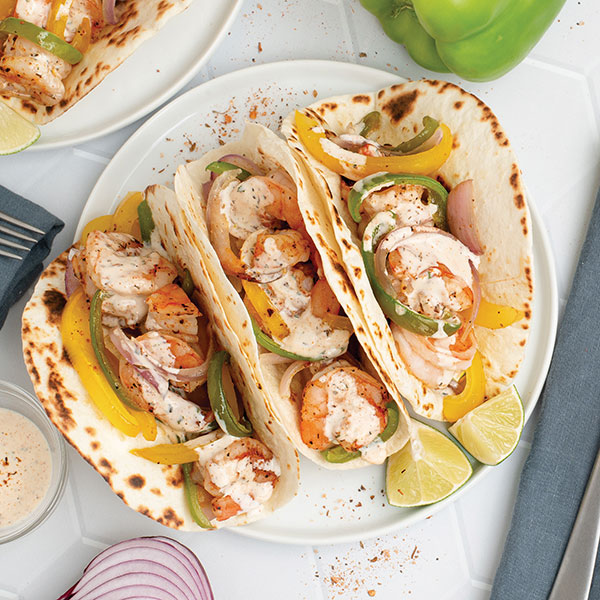
Sheet Pan Cajun Shrimp Fajitas with Bell Pepper, Onion and Spicy Ranch
Recipe courtesy of Albertsons
Total time: 30 minutes
Servings: 4
- 2 green bell peppers
- 2 yellow bell peppers
- 1 lime
- 1 medium red onion
- 2 tablespoons extra-virgin olive oil
- 1 1/2 pounds raw, peeled shrimp, fresh or frozen
- 5 teaspoons Cajun seasoning, divided
- 1 teaspoon salt
- 1/2cup ranch dressing
- 12 small flour tortillas
- Preheat oven to 450 F.
- Wash and dry green bell peppers, yellow bell peppers and lime.
- Trim, seed and slice bell peppers lengthwise into thin strips; transfer to large baking sheet.
- Peel, halve and slice onion lengthwise into thin pieces; add to baking sheet with bell peppers.
- Drizzle veggies with oil, toss to combine and spread in even layer. Bake until veggies have softened slightly, about 5 minutes.
- If using frozen shrimp, place them in colander and run under cold water to thaw slightly. Place shrimp on clean towel or paper towels and pat dry.
- Remove baking sheet from oven. Arrange shrimp over veggies then sprinkle with 4 teaspoons Cajun seasoning and salt; toss to combine and spread in even layer.
- Bake until veggies are tender and shrimp are cooked through, 5-7 minutes. Remove from oven.
- Cut lime into wedges.
- In small bowl, stir ranch dressing and remaining Cajun seasoning.
- Warm tortillas in skillet, oven or microwave, if desired.
- Divide tortillas between plates and fill with shrimp and veggies; drizzle with spicy ranch and serve with squeeze of lime.
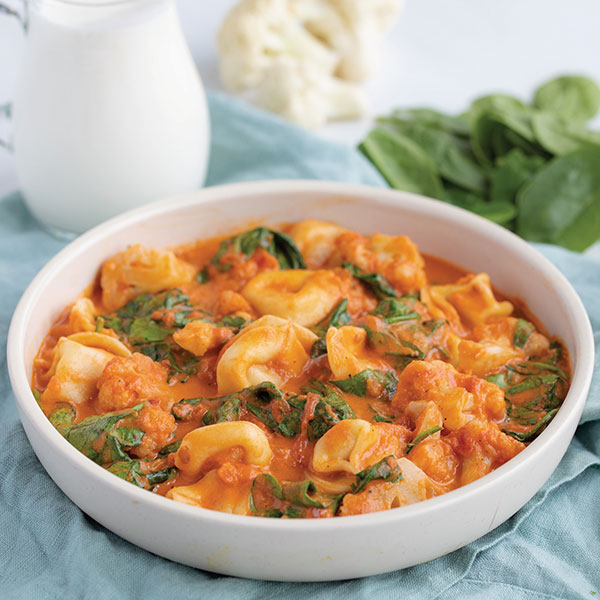
Cheese Tortellini and Cauliflower with Creamy Spinach Marinara
Recipe courtesy of Albertsons
Total time: 20 minutes
Servings: 4
- 2 bags (10 ounces each) cauliflower florets
- 18 ounces cheese tortellini, fresh or frozen
- 1/2 tablespoon salt
- 1 jar (24 ounces) marinara sauce
- 8 fluid ounces heavy whipping cream
- 1/2 teaspoon basil, dried
- 1/4 teaspoon black pepper
- 2 packages (5 ounces each) baby spinach
- Fill large pot halfway with hot water, cover and bring to boil. Uncover then add cauliflower, tortellini and salt; stir for a few seconds. Cook, stirring occasionally, until just tender, about 5 minutes, or cook according to package instructions.
- In separate large pot over medium heat, stir marinara sauce, cream, basil and black pepper to combine and bring sauce to simmer. Once simmering, reduce heat to medium-low and cook until slightly thickened, 3-4 minutes.
- Wash and dry spinach.
- When sauce has thickened, add spinach to pot in handfuls, waiting for spinach to wilt slightly before adding next handful. Remove from heat and cover to keep warm.
- When cauliflower and tortellini are done, drain and add to pot with creamy marinara sauce; stir to combine.
- To serve, divide pasta between plates or bowls.
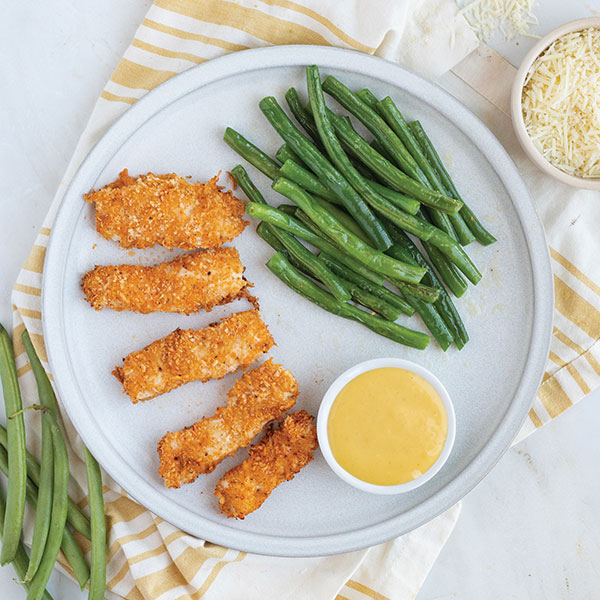
Garlic-Parmesan Chicken Tenders with Green Beans and Honey Mustard Dip
Recipe courtesy of Albertsons
Total time: 30 minutes
Servings: 4
- 2 tablespoons extra-virgin olive oil, divided
- 1/4 cup mayonnaise
- 1 teaspoon garlic powder
- 1 teaspoon salt, divided
- 2/3 cup Parmesan cheese, shredded
- 1/2 cup panko breadcrumbs
- 1/2 teaspoon paprika
- 1 1/2 pounds boneless, skinless chicken breasts
- 1 1/2 pounds green beans
- 1/2 cup honey mustard dressing
- Preheat oven to 450 F. Coat baking sheet with 2 teaspoons oil.
- In medium bowl, stir mayo, garlic powder and 1/2 teaspoon salt to combine.
- In separate medium bowl, stir Parmesan, breadcrumbs and paprika to combine.
- Pat chicken dry with paper towels and slice into 3/4-inch tenders. Add to bowl with mayo mixture and toss to coat.
- Working in batches, dredge tenders in breadcrumb coating, pressing to adhere. Transfer to baking sheet.
- Bake until tenders start to turn golden, about 10 minutes.
- On clean cutting board, wash, dry and trim green beans. Set aside.
- When chicken is golden, flip and bake until cooked through, 6-8 minutes. Remove from oven.
- Preheat large skillet over medium-high heat.
- Add remaining oil and swirl to coat bottom. Add green beans and remaining salt; cook, stirring occasionally, until tender-crisp, 4-5 minutes. Remove from heat.
- Divide chicken tenders and green beans between plates. Serve with dressing for dipping.
Source: Albertsons
Serve Flavorful, Sustainable Seafood
(Family Features) Whether seafood night at your house means sauteed shrimp, baked fish or anything in between, it’s an exciting excuse to bring the family together for favorite meals. Delicious recipes abound when seafood is on the menu.
However, this is no longer your grandparents’ seafood. Today, more than half of all seafood consumed in the U.S. is farm-raised – a practice known as aquaculture. While the industry has made strides throughout the last few decades, from increasingly sustainable farming practices to technological advancements that can help feed a growing population, not all farmed seafood is equal and neither are the certifications you see on its packaging.
For more than a decade, the global nonprofit Aquaculture Stewardship Council (ASC) has created and enforced the world’s strictest standards for farmed seafood. Its sea green ASC certification label is only found on farmed seafood that meets these high standards – helping seafood shoppers make informed purchasing decisions.
It’s a movement some of the nation’s leading seafood grocers and chefs are getting behind.
“About 2/3 of our seafood offerings are raised on farms, which reflects both growing supply and demand,” said Abe Ng, CEO of the Sushi Maki restaurant chain and market stations. “There’s a much broader customer understanding and appreciation of aquaculture than, say, 10 years ago. However, not all farmed seafood is equal in terms of quality, environmental sustainability and social responsibility.”
A unique combination of standards help ensure supply chain integrity from the farm to the store while protecting the environment, workers and communities. ASC’s sea green label only appears on seafood from farms that have been independently assessed and certified as environmentally and socially responsible.
“Whether your seafood is wild-caught or farmed, what matters to today’s shoppers is that it’s high-quality, flavorful and was fished or farmed in a responsible way that’s good for you and the planet,” said Roger O’Brien, president and CEO of the Santa Monica Seafood market and cafe. “Farm-raised seafood that’s been responsibly certified by the ASC delivers on the assurance that the seafood you’re buying is what it claims to be, which is a key commitment we make to our customers.”
With a trusted certification like the ASC, you can confidently enjoy make-at-home recipes like Honey Mustard Crunch Salmon, Blackened Shrimp Tacos with Creole Remoulade Slaw and Almond Stuffed Rainbow Trout without sacrificing taste or sustainability.
To find more certification information and discover family-friendly seafood recipes, visit SeaGreenBeGreen.org.
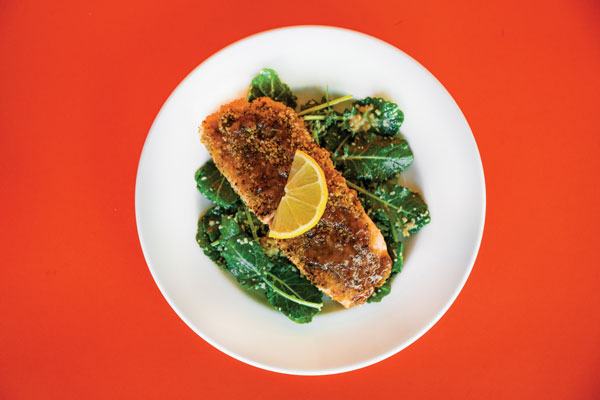
Honey Mustard Crunch Salmon
Recipe courtesy of North Coast Seafoods
- 1 bag (1 pound, three 6-ounce portions) North Coast Seafoods ASC-certified Naked Norwegian Salmon
- salt, to taste
- pepper, to taste
Honey Mustard Glaze:
- 1/3 cup honey
- 1/4 cup whole-grain mustard
- 2 tablespoons smooth Dijon mustard
- 2 tablespoons mayonnaise
- 2 teaspoons horseradish
- 1 teaspoon smoked paprika
Crunch:
- 3/4 cup panko breadcrumbs
- 2 tablespoons dried parsley
- 2 tablespoons olive oil
- Thaw salmon and pat dry. Arrange on oiled baking tray. Season with salt and pepper, to taste.
- To make glaze: In small bowl, combine honey, mustard, Dijon mustard, mayonnaise, horseradish and paprika; mix until well combined. Chill glaze until ready to use.
- To make crunch: In bowl, combine breadcrumbs, parsley and oil; mix well. Reserve.
- Preheat oven to 400 F.
- Top each salmon portion with 1 tablespoon glaze and spread evenly over fish. Press crunch evenly onto glaze.
- Bake 15-17 minutes until fish is cooked through.
- Serve with drizzle of remaining glaze.
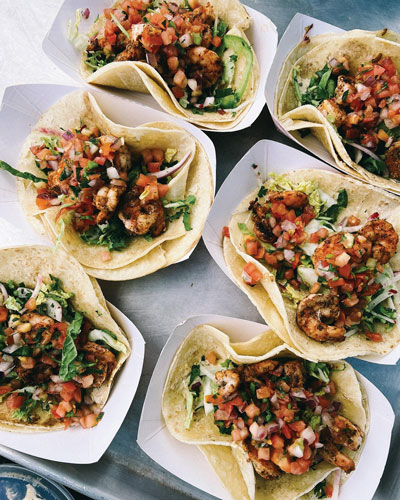
Blackened Shrimp Tacos with Creole Remoulade Slaw
Recipe courtesy of Coastal Seafoods and Fortune Fish & Gourmet
Prep time: 30 minutes
Cook time: 10 minutes
Coleslaw:
- 1/3 cup mayonnaise
- 1 tablespoon capers, chopped
- 1 teaspoon stone ground mustard
- 1/3 cup parsley, chopped
- 1/2 teaspoon horseradish
- 1/3 cup red onion, diced
- 1 tablespoon Cajun seasoning
- 1/2 bag coleslaw mix
Tacos:
- 6 small corn tortillas
- 1 tablespoon Cajun seasoning
- 1/2 pound peeled and deveined ASC-certified shrimp, thawed
- 3 green onions, sliced
- fresh salsa or pico de gallo (optional)
- 1 lime, sliced (optional)
- To make coleslaw: In bowl, mix mayonnaise, capers, mustard, parsley, horseradish, red onion and Cajun seasoning. Mix coleslaw and about 3/4 of dressing. Stir until coated then add more dressing, if desired. Refrigerate coleslaw until ready to serve.
- To make tacos: Heat grill to medium heat. Once hot, toast tortillas on each side until browned on edges. Stack toasted tortillas on plate and cover with towel until ready to serve.
- Pour Cajun seasoning over shrimp and stir until shrimp are coated.
- Cook shrimp 3-5 minutes per side, or until shrimp are firm and Cajun seasoning is blackened. Remove shrimp from grill to prevent overcooking.
- To serve, place about 1/4 cup coleslaw in each tortilla then top with 3-5 shrimp and green onions. Top with salsa or pico de gallo, if desired. Squeeze wedge of fresh lime over top, if desired.
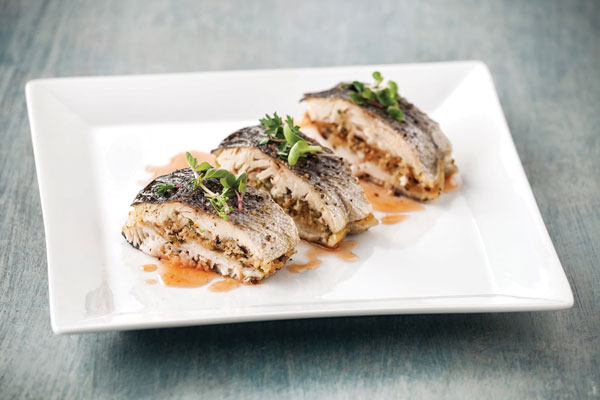
Almond Stuffed Rainbow Trout
Recipe courtesy of Riverence Provisions
- 2 ASC-certified Riverence Steelhead Trout fillets (8 ounces each)
- nonstick cooking spray
- 1/2 cup sliced almonds, toasted and coarsely chopped
- 2 tablespoons lemon zest
- 2 tablespoons lemon juice
- 1/4 cup chives, chopped
- 1 1/2 cups breadcrumbs
- 1/4 cup Italian parsley
- salt, to taste
- pepper, to taste
- 1 egg, beaten
- kitchen twine (6-inch lengths)
- 1 tablespoon olive oil
- Preheat oven to 350 F.
- Rinse steelhead trout fillets and pat dry with paper towel. Line baking pan with parchment paper and spray with nonstick cooking spray.
- Mix almonds, lemon zest, lemon juice, chives, breadcrumbs and parsley. Season with salt and pepper, to taste.
- Add beaten egg to breadcrumb mixture and stir until well incorporated.
- Lay first trout fillet skin side down on baking pan. Place twine pieces underneath fish, spacing 1 1/2 inches apart; leave untied.
- Place breading mixture over trout fillet and remaining trout fillet on top of breadcrumb mixture, skin side up.
- Secure trout fillets together using kitchen twine. Brush olive oil on trout and sprinkle with salt and pepper, to taste.
- Bake 15-20 minutes, or until fish is cooked through. Slice into portions to serve.
Source: Aquaculture Stewardship Council
Everyone's Favorite Fish Revealed: Alaska Pollock
Alaska Pollock Fish Stick Tacos
Alaska Surimi Seafood Breakfast Bake
Thai Fishermen's Stew
(Family Features) - Surprise! You already know this mild-tasting, delicately textured fish that swims wild in clean, icy Alaskan waters. You just didn't realize it.
Like the boy next door who's so friendly and easy going he's taken for granted - until his superman talents are revealed - genuine Alaska Pollock is finally making a name for itself. A kissing cousin to cod, this whitefish is the one you love to eat in so many good things, from fish sticks and fish tacos, to fish sandwiches, fillets and surimi seafood. It's a rock star in fish and chips, too.
Versatility is where Alaska Pollock scores top points. Alaska Pollock is flash-frozen within hours of harvesting and processed for breaded fish sticks, frozen fillets or surimi seafood. Its mild flavor and snow-white, tender flesh are particularly kid-friendly and appealing.
On the nutrition side, Alaska Pollock is a terrific source of protein and minerals, making it especially popular during Lent. Low in fat and calories, it's a product worth seeking out year-round.
Add sustainability as another plus for Alaska Pollock, harvested from the largest sustainable fishery in the world. Alaska Pollock fishery managers strive - and have for more than 30 years - to maintain the quality and capacity of the biannual catch while protecting the species' habitat and ecosystem in the Bering Sea and Gulf of Alaska. The result of their long-term dedication is an abundant, economical fish.
The versatility of Alaska Pollock is highlighted with the cross-cultural flavors in the trio of recipes here. Traditional Thai ingredients such as red curry paste, ginger, green chiles and coconut milk spark Thai Fishermen's Stew, a zesty dish with built-in warmth for an evening meal. Classic south-of-the-border seasonings give Alaska Pollock Fish Stick Tacos lively flavor with plenty of family appeal. What's not to like about pairing fish sticks with guacamole, taco seasoning, lime juice, green onions and cilantro? Or prepare Alaska Surimi Seafood Breakfast Bake. It's an easy-to-make frittata-type dish that matches Mexican seasonings with Alaska surimi seafood.
Add everything together and there's no question genuine Alaska Pollock is one tasty fish worth looking for in all its delicious forms. To find more recipes featuring this versatile fish, visit alaskaseafood.org.

Alaska Pollock Fish Stick Tacos
Ingredients
- 8 frozen Alaska Pollock fish sticks (about .75 ounces each) or 4 frozen breaded/battered fish fillets (about 1.5 ounces each)
- 8 taco shells or flour tortillas (5- to 6-inch each)
- 2 cups shredded lettuce
- 1 cup prepared guacamole
- 1 cup chopped tomatoes
- 1 teaspoon Mexican or taco seasoning
- 1 lime, cut in 8 wedges
- 1/2 cup chopped cilantro
- 1/4 cup sliced green onions
Preparation
- Prepare fish sticks/fillets according to package directions.
- In each taco shell, layer 1/4 cup lettuce, 2 tablespoons guacamole, 2 tablespoons tomato, and 2 fish sticks or 1 fish fillet.
- Sprinkle on small amount of Mexican or taco seasoning. Squeeze juice of a lime wedge over fish.
- Top with 1 tablespoon cilantro and 1/2 tablespoon green onions.
Preparation Time
15 minutes
Cook Time
15 minutes
Calories: 322g Total Fat: 18g
Cholesterol: 10mg Protein: 8g
Carbohydrates: 34g Sodium: 260mg
Serves
Servings 4

Alaska Surimi Seafood Breakfast Bake
Ingredients
- 1 large bell pepper, cut into strips
- 2 cups sliced mushrooms
- 1 can (4 ounces) sliced black olives, drained
- 1/3 cup sliced green onions
- 12 ounces Alaska Surimi Seafood (Imitation Crab)
- 1-1/2 to 2 teaspoons Cajun, Creole or Mexican seasoning
- 1 cup (4 ounces) shredded Colby Jack or Mexican cheese blend, divided
- 8 eggs
- 3/4 cup water
Preparation
- Preheat oven to 400°F.
- Spray coat 9- to 10-inch baking dish. Place peppers, mushrooms, olives and green onions in baking dish. Sprinkle seasoning over Alaska Surimi Seafood; stir to coat. Add surimi and 3/4 cup cheese to baking dish. Blend eggs and water; pour over surimi. Top with remaining 1/4 cup cheese.
- Bake 18 to 20 minutes, until puffed and center is firm.
Preparation Time
10 minutes
Cook Time
20 minutes
Calories: 324g Total Fat: 19g
Cholesterol: 374mg Protein: 25g
Carbohydrates: 14g Sodium: 1171mg
Serves
Servings: 4 to 6

Thai Fishermen's Stew
Ingredients
- 2 bottles (8 ounces each) clam juice
- 1 can (14.5 ounces) organic
- tomatoes with basil and garlic
- 1 can (4 ounces) chopped green chiles
- 2 teaspoons Thai red curry paste, or to taste
- 1 tablespoon grated fresh ginger
- 1 tablespoon brown sugar
- 1-1/2 tablespoons fish sauce, or to taste
- 1 can (14 ounces) regular or light coconut milk
- 1-1/2 pounds Alaska Pollock fillets, fresh, thawed or frozen
- 2 tablespoons grapeseed oil
- 1/2 cup chopped fresh basil leaves
Preparation
- In Dutch oven, combine first 7 ingredients. Simmer covered 15 minutes. Stir in coconut milk and continue to simmer but do not boil.
- Meanwhile, preheat broiler oven to 450°F. Rinse any ice glaze from frozen Alaska Pollock under cold water; pat dry with paper towel. Brush both sides of fillets with oil and place in baking pan. Broil 4 to 5 inches from heating element until opaque, about 5 to 6 minutes for frozen Alaska Pollock or 3 to 4 minutes for fresh/thawed fish. Cook just until fish is opaque throughout.
- Remove fillets from pan and break into large chunks. Stir into stew; bring to a simmer. Sprinkle with basil leaves and serve piping hot.
Calories: 241g Total Fat: 10g
Cholesterol: 83mg Protein: 25g
Carbohydrates: 10g Sodium: 839mg
Serves
Servings 6



